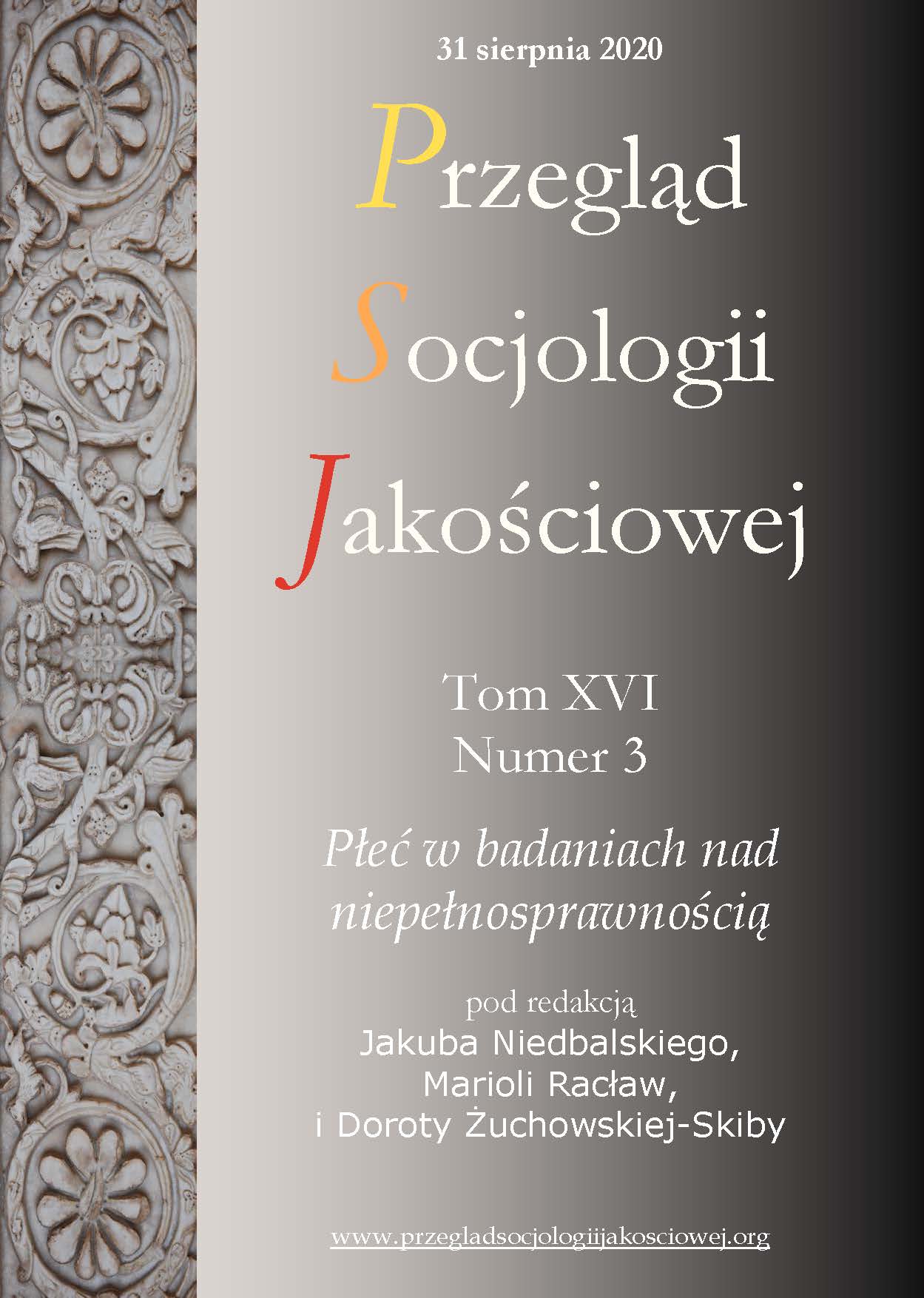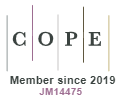Hybrid identities? Trajectories of the Lives of Women with Acquired Disabilities
DOI:
https://doi.org/10.18778/1733-8069.16.3.05Keywords:
identity, women with disability, acquired disability, physical disability, turning pointAbstract
In the study of disability, an extremely important role is played by issues related to identity changes occurring under the influence of experiences which alter the current course of life and force the adoption of new roles and the adaptation of previously fulfilled roles. This is the nature of a disability acquired in adulthood. It is a turning point that transforms the identities of women who must redefine themselves and their places in a reality that is new to them. The main goal of the article will be to show the changes that affect the identities of women who, as a result of an accident, acquired disability in adulthood. The study is based on autobiographical narrative interviews. This method allowed me to reconstruct the trajectory of the lives of the respondents, showing the process-like nature of the identities they shape, which have undergone changes under the influence of the need to adapt to the conditions resulting from the acquired disability. Six women – diversified in terms of age, education, professional position, and family situation, all of which influenced their roles and social positions – were surveyed.
Downloads
References
Asch, Adrienne and Michelle Fine Michelle. 1988. “Introduction: Beyond pedestals.” Pp 1-37. in Women with disabilities: Essays in psychology, culture, and politics, edited by A. Asch and M. Fine. Philadelphia, PA: Temple University Press.
Google Scholar
Asch, Adrienne and Michelle Fine. 1997. “Sexuality and Women with Disabilities: The Example of Women and Literature.” Pp. 241-255 in Disability Studies Reader, edited by L. Davis. New York, London: Routledge.
Google Scholar
Barnes, Coli and Geof Mecer. 2008. Niepełnosprawność. Warsaw: Sic!
Google Scholar
Barnwell, Alice M. and David J. Kavanagh. 1997. “Prediction of psychological adjustment to multiple sclerosis.” Social Science and Medicine 45:411-418.
Google Scholar
DOI: https://doi.org/10.1016/S0277-9536(96)00356-5
Beckwith, Alison, and Matthew Kwai-Sang Yau. 2013. “Sexual recovery: Experiences of women with Spinal injury reconstructing a positive sexual identity.” Sexuality and Disability 31:313-324.
Google Scholar
DOI: https://doi.org/10.1007/s11195-013-9315-7
Begum, Nasa. 1992. “Disabled Women and the Feminist Agenda.” Feminist Review 1(40):70-84.
Google Scholar
DOI: https://doi.org/10.1057/fr.1992.6
Brooks, Nancy and Mary Jo Deegan. 1981. “Women and Disability: The Double Handicap.” The Journal of Sociology and Social Welfare 2(8):229-231.
Google Scholar
Brooks, Nancy A., and Ronald R. Matson. 1982. “Social-psychological adjustment to multiple sclerosis: A longitudinal study.” Social Science and Medicine 16(24): 2129-2135.
Google Scholar
DOI: https://doi.org/10.1016/0277-9536(82)90262-3
Burke, Peter. 2009. Cultural hybridity. Cambridge: Polity Press.
Google Scholar
Campbell, Fiona K. 2009. Contours of Ableism: Territories, Objects, Disability and Desire. London: Palgrave Macmillan.
Google Scholar
DOI: https://doi.org/10.1057/9780230245181
Carr, David. 1986. Time, narrative and history. Bloomington, IN: Indiana University Press.
Google Scholar
Charmaz, Kathy. 1995. “The body, identity, and self: Adapting to impairment.” The Sociological Quarterly 36(4):657-680.
Google Scholar
DOI: https://doi.org/10.1111/j.1533-8525.1995.tb00459.x
Ciaputa, Ewelin, Agnieszka Król, and Marta Warat. 2014. “Genderowy wymiar niepełnosprawności. Sytuacja kobiet z niepełnosprawnościami wzroku, ruchu i słuchu.” Pp. 153-174 in Polscy niepełnosprawni: od kompleksowej diagnozy do nowego modelu polityki społecznej, edited by B. Gąciarz and S. Rudnicki. Cracow: Wydawnictwo AGH.
Google Scholar
Ciaputa, Ewelina et al. 2014. “Macierzyństwo kobiet z niepełnosprawnościami ruchu, wzroku i słuchu.” Studia Socjologiczne 2(213):203-224.
Google Scholar
Craig, Ashley R., Karen Hancock, and Esther Chang. 1994. “The influence of spinal cord injury on coping styles and self-perceptions two years after the injury.” Australian and New Zealand Journal of Psychiatry 2(28):307-312.
Google Scholar
DOI: https://doi.org/10.1080/00048679409075644
Deaux, Kay (1993) “Reconstructing social identity.” Personality and Social Psychology Bulletin 19(1):4-12.
Google Scholar
DOI: https://doi.org/10.1177/0146167293191001
Deaux, Kay. 2001. “Social identity.” Pp. 1059-1068 in Encyclopedia of women and gender, edited by J. Worrell. San Diego, CA: Academic Press.
Google Scholar
Deegan, Mary Jo. 2018. Women and disability: The double handicap. New York: Routledge.
Google Scholar
DOI: https://doi.org/10.4324/9781351318082-1
Dolch, Norman A. 2003. “Role.” Pp. 391-410 in Handbook of Symbolic Interactionism, edited by L. T. Reynolds and N. J. Herman-Kinney. Walnut Creek: Alta Mira Press.
Google Scholar
Ethier, Kathleen A. and Kay Deaux. 1994. “Negotiating social identity when contexts change: Maintaining identification and responding to threat.” Journal of Personality and Social Psychology 2(67):243-251.
Google Scholar
DOI: https://doi.org/10.1037/0022-3514.67.2.243
Ferri, Beth A. and Noel Gregg. 1998. “Women with disabilities: Missing voices.” Women’s Studies International Forum 4(21):429-439.
Google Scholar
DOI: https://doi.org/10.1016/S0277-5395(98)00038-7
Finger, Ann. 1991. Past Due: A Story of Disability, Pregnancy and Birth. Seattle: Seal Press.
Google Scholar
Finger, Ann. 1992. “Forbidden Fruit.” New Internationalist 233:8-10.
Google Scholar
Forber-Pratt Anjali J. et al. 2017. “Disability identity development: A systematic review of the literature.” Rehabilitation Psychology 62:198-207.
Google Scholar
DOI: https://doi.org/10.1037/rep0000134
Frank, Ann W. 1993. “The rhetoric of self-change: illness experience as narrative.” The Sociological Quarterly 1(34):39-52.
Google Scholar
DOI: https://doi.org/10.1111/j.1533-8525.1993.tb00129.x
Goethals, Tina, Elisabeth De Schauwer, and Geert Van Hove. 2015. “Weaving Intersectionality into Disability Studies Research: Inclusion, Reflexivity and Anti-essentialism.” Journal for Diversity and Gender Studies 2(1-2):75-94.
Google Scholar
DOI: https://doi.org/10.11116/jdivegendstud.2.1-2.0075
Gonçalves, Kellie. 2013. “‘Cooking lunch, that’s Swiss’: Constructing hybrid identities based on socio-cultural practices.” Multilingua 4(432):527-547.
Google Scholar
DOI: https://doi.org/10.1515/multi-2013-0026
Goodley, Dan. 2011. Disability Studies. An Interdisciplinary Introduction. London: Sage.
Google Scholar
Hancock. Marie A. 2007. “When Multiplication Doesn’t Equal Quick Addition: Examining Intersectionality as a Research Paradigm.” Perspectives on Politics 1(5):63-79.
Google Scholar
DOI: https://doi.org/10.1017/S1537592707070065
Hermanns, Harry. 1987. “Narrative interview – a new tool for sociological field research.” Acta Universitatis Lodziensis: Folia Sociologica 13:43-56.
Google Scholar
Hormuth, Stefan E. 1990. The ecology of the self: Relocation and self-concept change. Cambridge: Cambridge University Press.
Google Scholar
Hughes Rosemary B. et al. 2003. “Health promotion for women with physical disabilities: A pilot study.” Rehabilitation Psychology 3(48):182-188.
Google Scholar
DOI: https://doi.org/10.1037/0090-5550.48.3.182
Jenkins, Richard. 2005. Social Identity. London, New York: Routledge.
Google Scholar
Konecki, Krzysztof T. 2015. “Anselm L. Strauss—Pragmatic Roots, Pragmatic Implications.” Przegląd Socjologii Jakościowej 1(11):12-39.
Google Scholar
DOI: https://doi.org/10.18778/1733-8069.11.1.02
Król, Agnieszka. 2018. “Niepełnosprawność i sprawiedliwość reprodukcyjna. Zarys wybranych zagadnień dotyczących kobiet z niepełnosprawnościami.” Annales Universitatis Paedagogicae Cracoviensis. Studia de Cultura 1(10):84-99.
Google Scholar
DOI: https://doi.org/10.24917/20837275.10.1.7
Kubicki, Paweł. 2017. Polityka publiczna wobec osób z niepełnosprawnościami. Warsaw: Oficyna Wydawnicza SGH Szkoła Główna Handlowa w Warszawie.
Google Scholar
Kumaniecka-Wiśniewska, Agnieszka. 2006. Kim jestem? Tożsamość kobiet upośledzonych umysłowo. Warsaw: Wydawnictwo Akademickie.
Google Scholar
McDonald, Katherine E., Christofer Keys, and Fabricio E. Balcazar. 2007. “Disability, race/ethnicity and gender: themes of cultural oppression, acts of individual resistance.” American Journal of Community Psychology 39(1-2):145-161.
Google Scholar
DOI: https://doi.org/10.1007/s10464-007-9094-3
Milligan, Maureen S. and Alfred H. Neufeldt. 2001. “The myth of asexuality: A survey of social and empirical evidence.” Sexuality and Disability” 19(2):91-109.
Google Scholar
DOI: https://doi.org/10.1023/A:1010621705591
Moin, Victor, Ilana Duvdevany, and Daniela Mazor. 2009. “Sexual Identity, Body Image and Life Satisfaction Among Women With and Without Physical Disability.” Sexuality Disability 27:83-95.
Google Scholar
DOI: https://doi.org/10.1007/s11195-009-9112-5
Morris, Jenny. 1993. “Feminism and Disability.” Feminist Review 1(43):57-70.
Google Scholar
DOI: https://doi.org/10.1057/fr.1993.4
Moser, Ingunn. 2006. “Sociotechnical practices and difference: On the interferences between disability, gender, and class.” Science, Technology and Human Values 31(5):537-564.
Google Scholar
DOI: https://doi.org/10.1177/0162243906289611
Nosek, Margaret A. 1996. “Wellness among women with physical disabilities.” Pp. 17-33 in Women with physical disabilities: Achieving and maintaining health and well-being, edited by D. M. Krotoski, M. A. Nosek, and M. A. Turk. Baltimore: Brookes.
Google Scholar
Nosek, Margaret A. and Rosemary B. Hughes. 2003. “Psychosocial Issues of Women with Physical Disabilities: The Continuing Gender Debate.” Rehabilitation Counseling Bulletin 4(46):224-233.
Google Scholar
DOI: https://doi.org/10.1177/003435520304600403
Nosek, Margaret A. et al. 2003. “Self-esteem and women with disabilities.” Social Science and Medicine 56:1737-1747.
Google Scholar
DOI: https://doi.org/10.1016/S0277-9536(02)00169-7
Oyserman, Dafna. 2004. “Self-concept and identity.” Pp. 5-24 in Self and Social Identity, edited by M. B. Brewer and M. Hewstone: Hoboken: Blackwell Publishing.
Google Scholar
Piątek, Katarzyna. 2009. “Kilka uwag o trudnościach badawczych problemu niepełnosprawności – na przykładzie kobiet z niepełnosprawnością fizyczną.” Pp. 217-224 in Metody, techniki i praktyka badań społecznych, edited by A. Bąk and Ł. Kubisz-Muła. Bielsko-Biała: Wydawnictwo Akademii Techniczno-Humanistycznej.
Google Scholar
Riemann, Gerhard and Fritz Schütze. 1992. „‘Trajektoria’ jako podstawowa koncepcja teoretyczna w analizach cierpienia i bezładnych procesów.” Kultura i Społeczeństwo 2(36):89-108.
Google Scholar
Simon, Bernd. 2004. Identity in modern society: A social psychological perspective. Hoboken: Blackwell Publishing.
Google Scholar
Stojkow, Maria and Dorota Żuchowska-Skiba. 2018. “Hybrid identities? Trajectories of the fate of old Muslim women in Poland.” Revista Prisma Social 21:177-193.
Google Scholar
Strauss, Anselm L. 1959. Mirrors and masks. The search for identity. Chicago: University of Chicago Press.
Google Scholar
Strauss, Anselm L. 1995. “Identity, Biography, History, and Symbolic Representations.” Social Psychology Quarterly 1(58):4-12.
Google Scholar
DOI: https://doi.org/10.2307/2787139
Strauss, Anselm L. 2013. Zwierciadła i maski. W poszukiwaniu tożsamości. Kraków: Nomos.
Google Scholar
Szczęsna, Ewa. 2004. “Tożsamość hybrydyczna.” ER(R)GO 2(9):9-18.
Google Scholar
Taleporos, George and Mariat McCabe. 2002. “The impact of sexual esteem, body esteem, and sexual satisfaction on psychological well-being in people with physical disability.” Sexuality and Disability 20(3):177-183.
Google Scholar
DOI: https://doi.org/10.1023/A:1021493615456
Thomas, Carol. 1997. “The Baby and the Bath Water: Disabled Women and Motherhood in Social Context.” Sociology of Health and Illness 5(19):622-643.
Google Scholar
DOI: https://doi.org/10.1111/1467-9566.00073
Thomas, Carol. 1999. Female Forms: Experiencing and Understanding Disability. Buckingham: Open University Press.
Google Scholar
Tøssebro, Jan. 2004. “Understanding disability: introduction to the special issues of SJDR.” Scandinavian Journal of Disability Research 6(1):3-7.
Google Scholar
DOI: https://doi.org/10.1080/15017410409512635
Walsh, Anthony and Patricia Ann Walsh. 1989. “Love, self-esteem, and multiple sclerosis.” Social Science and Medicine 7(29):793-798.
Google Scholar
DOI: https://doi.org/10.1016/0277-9536(89)90078-6
Wendelborg, Christian and Jan Tøssebro. 2010. “Marginalisation processes in inclusive education in Norway: a longitudinal study of classroom participation.” Disability & Society 6(25):701-714.
Google Scholar
DOI: https://doi.org/10.1080/09687599.2010.505744
Wołowicz-Ruszkowska, Agnieszka. 2013. Zanikanie? Trajektorie tożsamości kobiet z niepełnosprawnością. Warsaw: Wydawnictwo APS.
Google Scholar
Downloads
Published
How to Cite
Issue
Section
License

This work is licensed under a Creative Commons Attribution-NonCommercial-NoDerivatives 4.0 International License.














